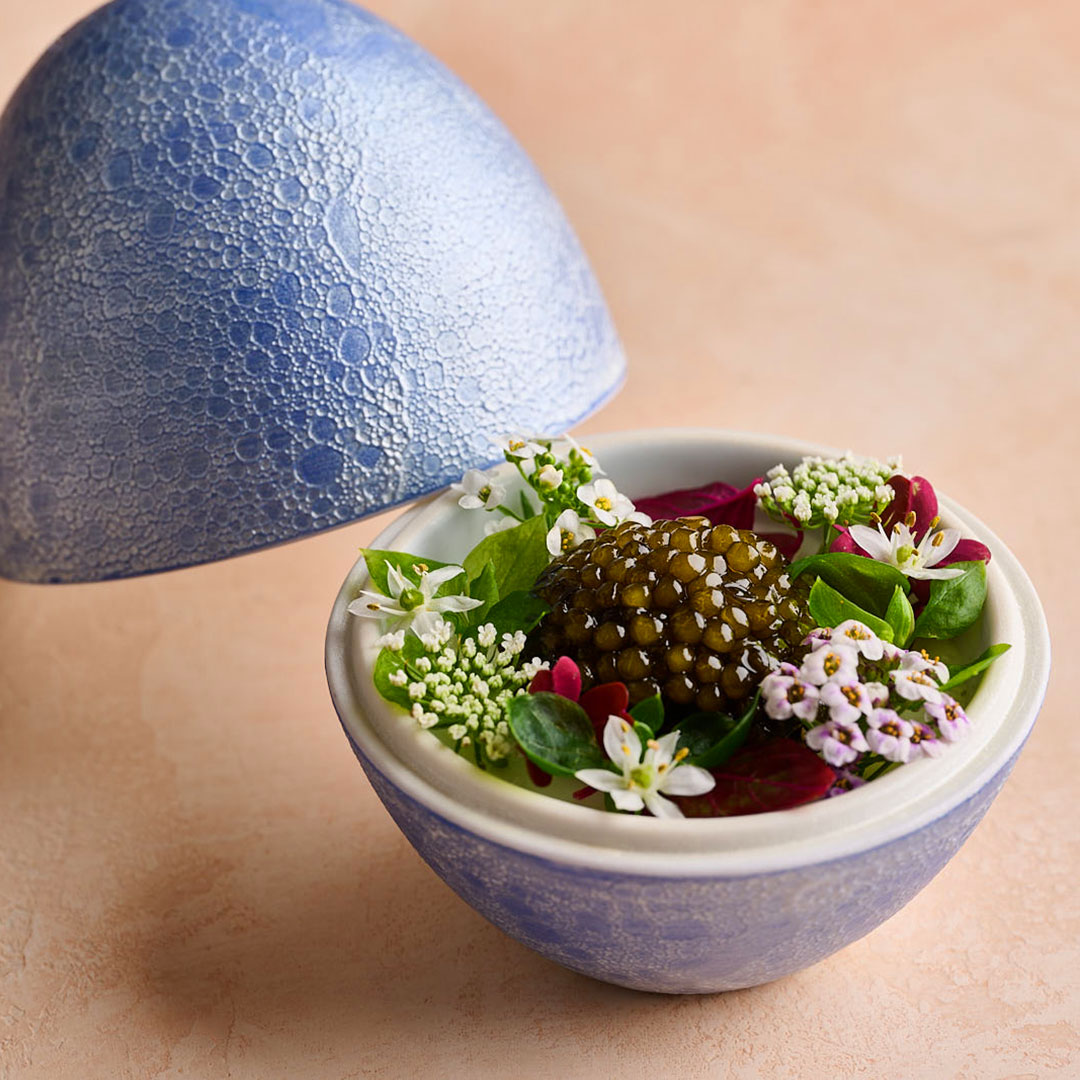Jean Sulpice, avid sportsman...
For this chef who works surrounded by mountains, sky and water, Nature is more than a passion: it is second nature. As a child, he dreamed of being a lumberjack, a forest ranger, a gardener. He would confide in the chickens and ducks about his heartache and woes. In the summer, he would collect hay from neighbouring farmers. Nowadays, he rides his mountain bike and regularly participates in the Pierra Menta – the internationally renowned ski mountaineering race; his sights are now set on the Patrouille des Glaciers, a race organised by the Swiss military (which one can only imagine is something of a white-knuckle ride), and also does a lot of top-level mountaineering in the company of the likes of Christophe Dumarest, high mountain guide and an international star.

... and herbalist chef
Rest assured, Jean Sulpice does take time out from high-octane pursuits. This herbalist chef's contemplative nature then comes to the fore. Born in Aix-les-Bains into a family of restaurateurs, he is also the chef at Auberge du Père Bise, a unique spot steeped in history, where some important moments in French gastronomy played out.
The large restaurant building, completely refurbished by Magali and Jean Sulpice, stands on the shore of Lake Annecy, in Talloires Bay, a sort of miraculous Eden with a Corsican feel. Opposite, at the narrowest point of this glacial lake, the Château de Duingt comes into view; to the left, the Roc du Chère, the lake's only rocky promontory, emerges from the translucent blue waters.

Close ties to the Savoyard terroir
This escarpment could be said to echo the duality of the chef and of his terroir: the southern slope is home to the Montpellier maple; meanwhile, the same rhododendrons as can be found on the slopes of the Himalayas grow on the sub-Alpine level, to the north. Similarly, the chef is influenced by both the lake and the mountains. His cooking features freshwater fish, aromatic plants from his kitchen garden, cheeses and wild flowers from the mountain pastures and elsewhere, and vegetables and meat from animals reared on the plains.
In praise of the living world
In all events, he remains faithful to his mantra: "to accompany the living world" in a kind of perpetual motion, alternating between bursts of energy and pensive stillness. At Auberge du Père Bise, the tasting menu is also a journey on the spot, designed like a notebook, a gourmet stroll through the chef's beloved Savoie region. Whitefish and pike from Lake Annecy, wild garlic, chamomile and immortelle from Italy, borage, marjoram, beaufort, watercress, sorrel, chard, young spruce shoots, meadowsweet: he leads diners from stream to torrent, path to garden, vegetable garden to forest, from stable to undergrowth.

A sensibility that unites cook and food producer
Behind this inventory worthy of Jacques Prévert and these pastoral dishes presented by an artist-chef, there are just as many stories of friendship – those built between Jean Sulpice and his suppliers. The chef only works with "enthusiasts", artisans who are also "artists", in other words, he looks out for "characters". "What makes for an ingredient of quality is the personality and sensibility of a producer who respects the living world," explains the chef. He cites, among others, Philippe Héritier, winegrower and snail breeder, Florent Capretti, one of only two remaining professional fishermen operating on Lake Annecy, cheese maker Caroline Joguet, and Francis Rousset, "self-taught" winegrower and apple juice producer.
From this communion with the elements, with nature and with the suppliers, the chef derives a philosophy that is, needless to say, "sustainable and local": "I only work with humble people who respect Nature and are aware of how lucky we are to benefit from all it offers". In his daily life, Jean Sulpice combats waste and overconsumption, two of the greatest scourges of our time.

Coffee, as a spice, a condiment, a seasoning, a structuring element
Coffee: another example of his sensitive approach to produce. Jean Sulpice has always liked working with coffee, which he considers to be "a spice, a seasoning, a condiment, a culture". "It's a flavour I appreciate very much; a condiment that can season an ingredient and work with it, warming it and spicing it up". The blend 100% Arabica illy also lends a "real structure", according to the Annecy native.

Pairing coffee with poultry, fish and vegetables
His recipe for Jerusalem artichoke and coffee matafan illustrates as much: a tablespoon of ground coffee is added to the traditional recipe for these country-style pancakes eaten in the Savoie, Dauphiné and Lyonnais areas. Jean Sulpice also likes to associate coffee with tender and delicate chicken meat to create a subtle harmony: "the crispy, salty skin lends the poultry a caramelised note, which marries wonderfully with the coffee, but whose powerful taste must come down on the side of finesse and elegance: a little crushed garlic cooked in its skin, some thyme – I roast the whole lot and leave this mixture to infuse in the chicken's juices. He also swears by cooking the bird in "a salt and coffee crust, with thyme and tarragon to add a touch of freshness – a subtle combination for the chicken meat."
And what about pairing coffee and fish? "I would go for a shellfish or something like freshwater monkfish or whitefish – a somewhat meaty flesh that can withstand the powerful flavour of coffee."
While a gentle infusion of coffee contributes a more delicate note, the chef is not against deploying its full force, as he does at Le Bistrot 1903, his luxury location: in the hazelnut and coffee blancmange served there, the coffee flavour "explodes".
Coffee, a quest for finesse
But what dominates Jean Sulpice's practice as a chef is the pursuit of subtlety, of the elegant harmony that will transcend a successful marriage of flavours. For this reason, he has distanced himself from smoking – a technique for preserving charcuterie and fish that is an integral part of the peasant culture of the mountain pastures and lakes. "It has become a fad," says the chef, who is wary of the excessive heat "which makes the beans burst, and brings a taste that is too massive, too potent". However, he is not against "a little roasting", which will produce a slight bitterness… and the acidity of coffee is somehow reminiscent of his favourite herbs, such as watercress or oxalis.
Beyond its taste, coffee has an incomparable strength thanks to its year-round use: "it is for every season, like a spice: I combine it with raspberries in spring, I use it in combination with hay in winter, or in coffee-flavoured crème caramel, as in my next book on cakes".

Coffee, a culture of connection
Beyond the recipes, dishes and work at the stove, coffee is part of a culture that is endorsed by the chef, both the individual and the sports enthusiast: "I like to drink a cup of coffee in the morning, a ritual that marks the start of the day. The taste of coffee is reassuring, comforting". For the team working in the kitchen, the coffee break remains a pillar of "[my] job as a restaurateur, which is to gather people around a table, with cups, a thermos, to take a moment together, an interlude to share and talk". Jean Sulpice is not a fan of capsules; he likes to hear the sound of the coffee machine, to smell the coffee as it percolates: "coffee is part of life, it is the social aspect that puts the magic into Italian coffee". As a sportsman, he also appreciates a coffee with friends after a bike ride or a mountain excursion. It is true that the turquoise water of Lake Annecy is an even greater feast for the eyes as you sip an espresso.






















